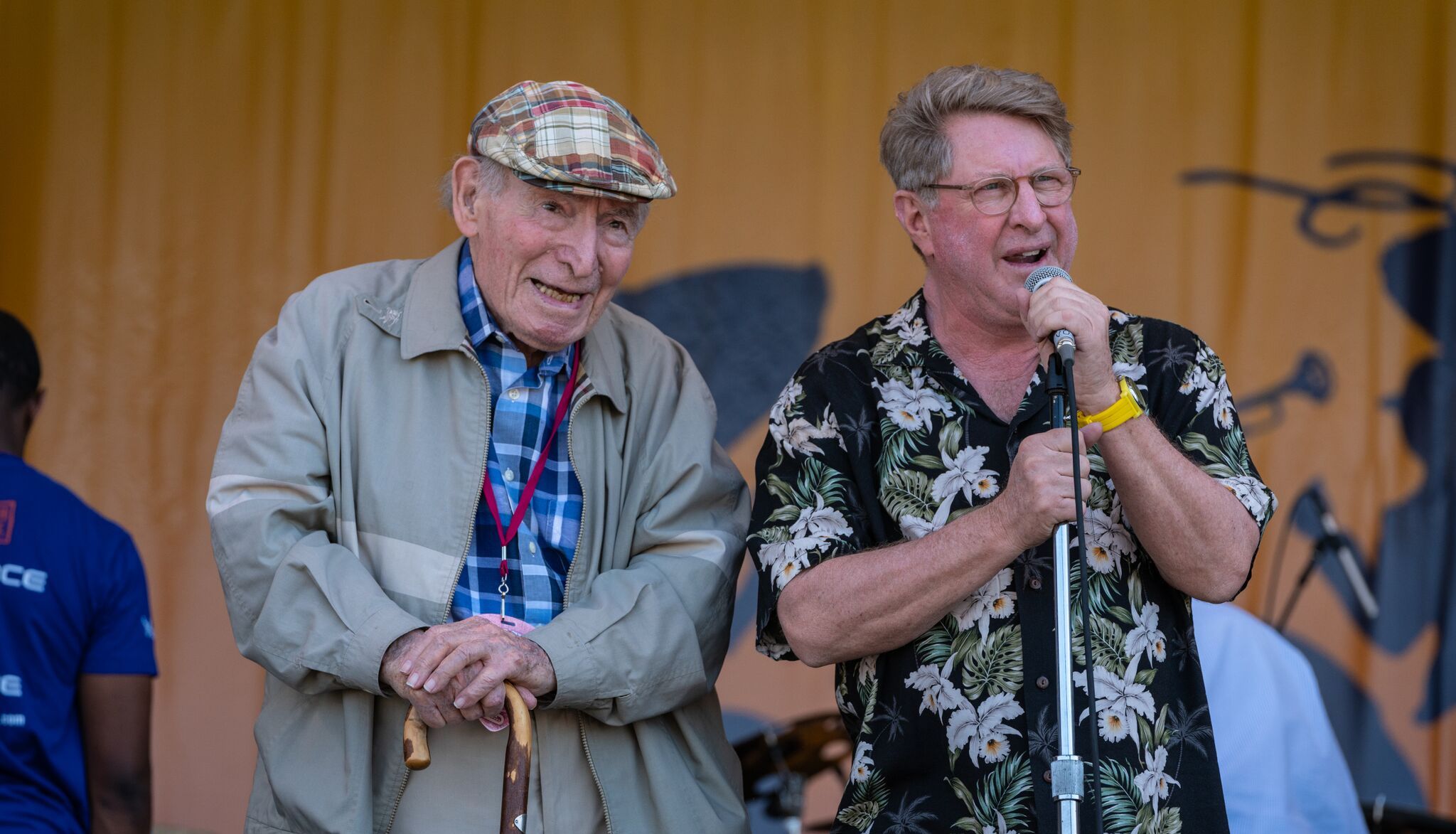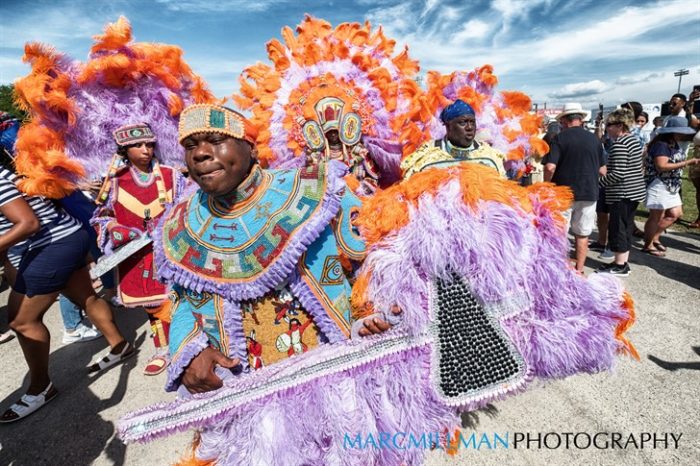Relix 44: New Orleans Jazz & Heritage Festival Turns 50

George Wein and Quint Davis at Jazz Fest (photo by Douglas Mason)
Welcome to the Relix 44. To commemorate the past 44 years of our existence, we’ve created a list of people, places and things that inspire us today, appearing in our September 2018 issue and rolling out on Relix.com throughout this fall. See all the articles posted so far here.
Golden Year: New Orleans Jazz & Heritage Festival Turns 50
When the 2019 edition of the New Orleans Jazz & Heritage Festival kicks off on April 26, this will mark the 50th year of the venerable event. It is one of the few festivals that maintains both a local identity and an international scope. Although the festival debuted in 1970, founder George Wein was first approached eight years earlier, following his success creating the Newport Jazz Festival in 1954 and Newport Folk Festival in 1959.
Wein recalls:
It started in 1962. Because of my reputation with the Newport Jazz Festival, I was asked by a community board—consisting of the hotel association, the Chamber of Commerce and the Board of Trade for the City of New Orleans—to come and produce its own jazz festival in the style of Newport.
1962 was too early. Jim Crow laws still ruled the roost in the South. The laws of segregation made it impossible to present international musicians of mixed cultural backgrounds.
After many stops and starts, I was given a contract to produce the first New Orleans Jazz Festival and Louisiana Heritage Fair in 1970. I chose this title after having the privilege of spending the ‘60s working with Pete Seeger on the Newport Folk Festival—famous for Bob Dylan going electric.
In coming to New Orleans since 1962, I had become totally aware of the phenomenal local culture of food, crafts and music that had a daily expression in the lives of New Orleanians. Instead of doing just a jazz festival, I utilized my experience in working with both folk and jazz music in Newport.
I needed to build a local team and found a young man named Quint Davis. Little did I know that this 21-year-old kid would become one of the great producers in the history of American music.
The 1970 festival was held in Beauregard Square—now Congo Square—and drew a crowd of less than 300 people. But the formula of multiple stages, and food and crafts booths still exists today and draws hundreds of thousands of people every year to the Crescent City.
Why is the New Orleans Jazz & Heritage Festival (NOJHF) a continuous success? The city is a destination in itself. People from around the world want to come to New Orleans. This great festival wraps into one package—the food, crafts and totality of music found in New Orleans and Louisiana.
I was completely involved in producing this festival in its infancy but, slowly, Quint Davis has made his personality and talent synonymous with what is the NOJHF. As long as there is the City of New Orleans, there will always be a New Orleans Jazz & Heritage Festival.
 Jazz Fest 2018
Jazz Fest 2018
Quint Davis, the event’s producer and director, as well as CEO of Festival Productions Inc.–New Orleans, shares his own perspective:
George Wein is a visionary. That first year, he had brought down Mahalia Jackson and Duke Ellington, and he had commissioned Duke to do the “New Orleans Suite.” And he told them: “You’ve gotta come out to this little heritage fair during the day.” There was a little tent top down in Congo Square with an upright piano in the grass, not even a stage, and gospel singers were playing there. There were four little outdoor stages that had Cajun and zydeco and Professor Longhair and Snooks Eaglin playing blues and a little food and a little crafts. And then we had the Eureka Brass Band doing jazz funerals and it was the first place the Mardi Gras Indians ever appeared.
Mahalia is from New Orleans; she’s from the Pearl Street area by the levy, so that was a sensation. She was standing in the middle and the Eureka Brass Band, which is the birthright of jazz, was proceeding around her. Then they stopped and started playing “Closer Walk with Thee,” and she started singing it with them. So now you have the world’s greatest gospel singer, maybe ever, from New Orleans who’s singing a gospel hymn with a marching funeral brass band. And we’ve never gotten away from that. The festival is big now, but it still has that same palette.
We have 5,000 musicians playing 13 stages over seven days, and maybe 800 of them are not local. Basically what happens is, now that it’s grown to this point, on each day a given stage will have one guest that we want to be the greatest living exponent of that genre. And then all the rest of the artists are from here. I think the musicianship, the playing and the singing on our stages hour-to-hour, within our genres, is unequalled. But go around the field— we probably have a thousand gospel singers, alone. We have a gospel tent, a blues tent, three stages with jazz on them—contemporary, traditional second line and traditional New Orleans jazz—a Cajun zydeco stage, R&B, funk, Caribbean, African and Latin.
People sometimes think that heritage is about looking in the rearview mirror, which it is, but you’ve gotta look through the windshield too. It moves in both directions. So at the same time that you define and live in the history that you’re celebrating, you’re also looking forward toward what’s next. So you have Ellis Marsalis and then Wynton Marsalis and then Terence Blanchard and then Nicholas Payton. Look at the brass bands, where you went from the traditional Olympia Brass Band to the Dirty Dozen, who took it to a different place. And then after the Dirty Dozen you had Rebirth, who took it to yet another place. And now we have thirty brass bands that play the festival. A lot of them are young and they’re playing brass-hop, they’re playing Marvin Gaye songs in the street—which doesn’t mean they can’t play traditional as well. Our culture not only endures but it’s exploding, it’s also growing. This is a golden era.
And don’t forget the food! I don’t think there’s food at a festival like this one. We’re churning out hundreds of thousands of servings of gourmet food for 10 bucks on a paper plate in a field. And I mean pheasant quail, andouille gumbo, soft-shell crab on a buttered bun, crab meat po’boys, trout baquet, crawfish strudel.
This festival has always been handmade and it’s still handmade. We have a crew that builds the stages, we have a crew that builds the food booths, we have an electrical crew that does all the electrical, we have trailer crews that go in and put in the plumbing and everything, and all the signs are hand-painted and hand- drawn—Nan the sign lady is a famous historical figure because she does every sign by hand every year. That’s been important for us as well. Even though it gets bigger, we try to stay grounded in our structure and our operation.
Of course, the people who attend, are the ones who make the festival. Without them, we’re putting on the world’s greatest soundcheck. They’ve been coming for 50 years—that’s three generations. People have moved here and got married because of the festival. The music is woven into their lives, which happens to people in general and a little more so here in New Orleans.
This article originally appears in the September 2018 issue of Relix. For more features, interviews, album reviews and more, subscribe here.



















